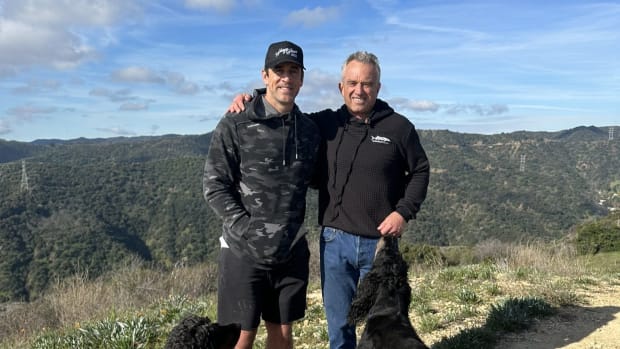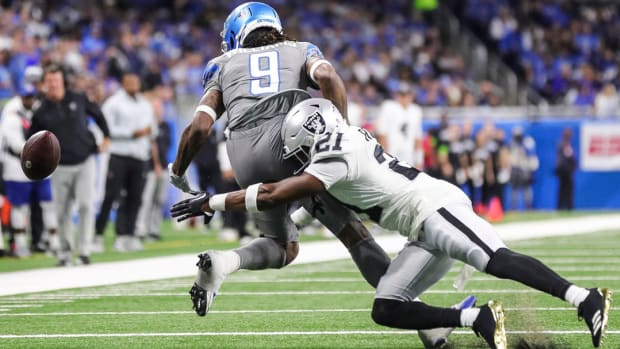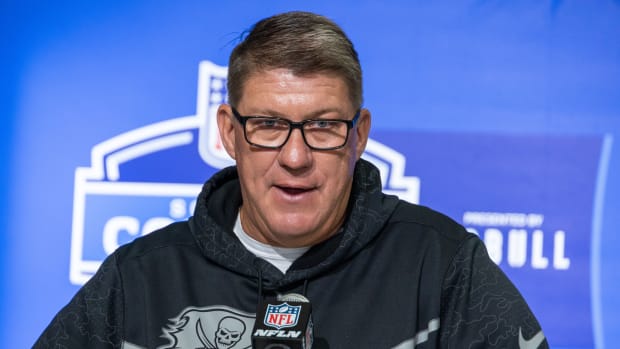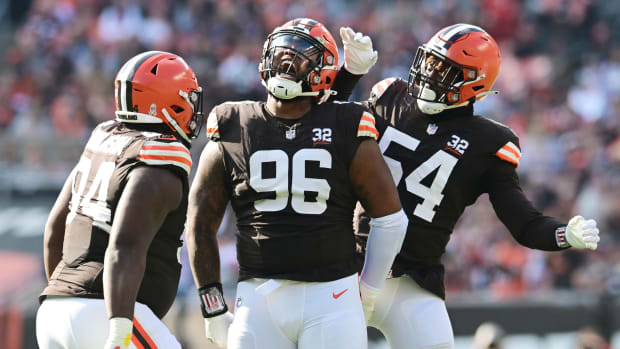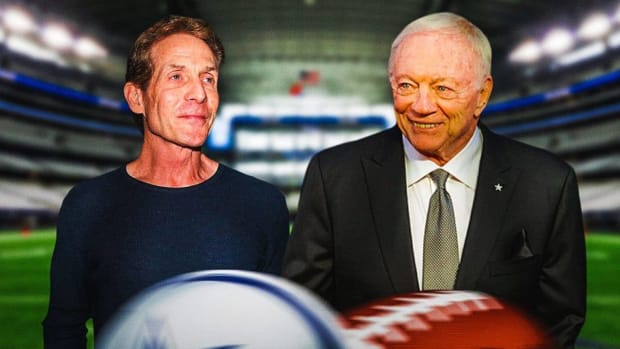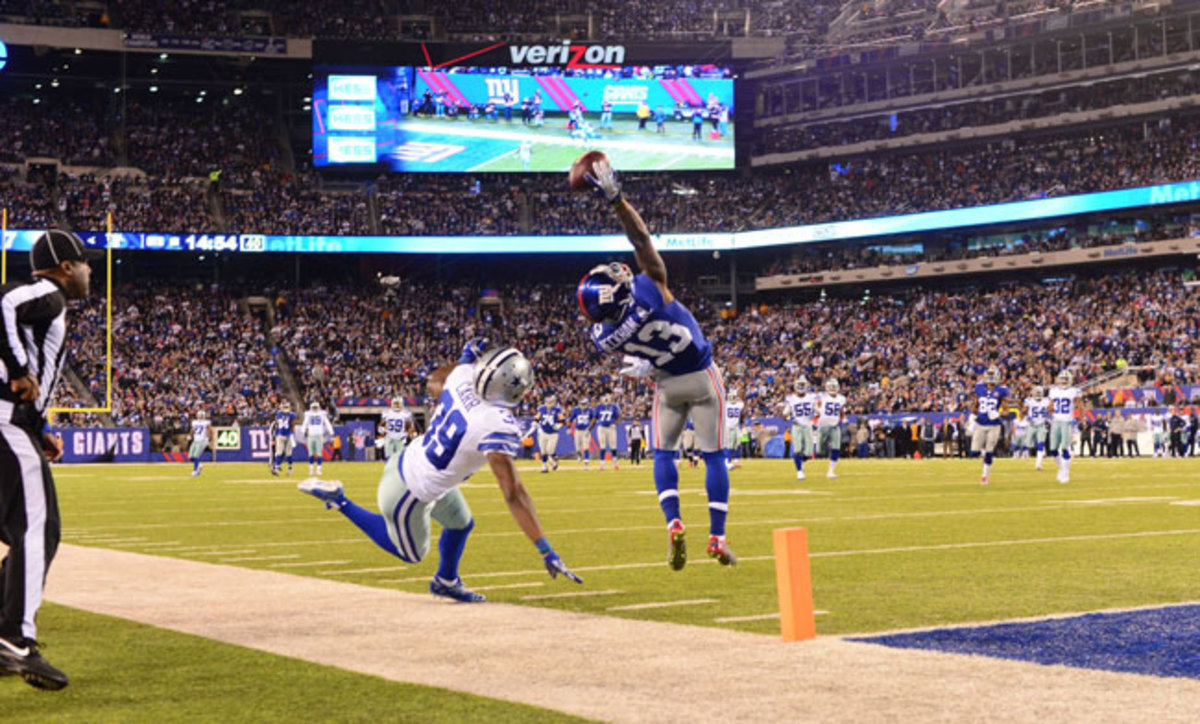
Transcending ‘The Catch’
When fans think about Odell Beckham Jr., they think about The Catch. Understandable. But defensive coordinators who have to face the Giants go back to that Cowboys game and think about all the different ways in which Beckham was used. The Catch was gravy on an all-around sensational night; the rest of the contest offered a startling illustration of Beckham’s wide-ranging talent.
Against the Cowboys, Beckham played in the slot, outside and out of the backfield. He shifted before the snap. He went in motion. He ran a variety of routes—some deep, some swinging toward the sideline, many toward the middle of the field. In addition to The Catch, he hauled in nine other passes for 103 yards and a touchdown, bringing his total haul to 10, 146 and two. A lot of damage was done via the basics: shallow crosses, hook routes, wide receiver screens and deep comebackers—all ways in which Beckham can dominate, given how he has the best short-area agility and stop-start quickness of any receiver in the league (including the former standard-setter, Antonio Brown).
Beckham could have had a lot more than 1,305 yards last season; there were several instances when he burned defenders deep but, for a variety of reasons, didn’t get the ball. He has a chance to be more than a superstar. He has a chance to be transcendent, to become the most valuable player at his position in just the second year of his career.
For this to happen, offensive coordinator Ben McAdoo must continue being creative in the way he deploys the 5’11”, 198-pound receiver.
Think about how McAdoo wants to play. He hails from Green Bay, where he was the quarterbacks coach for a West Coast spread-style offense that often used variations on the three-receiver set. The passing game there was built not on the usual three-and five-step timing, but on two-and four-step timing, to take advantage of Aaron Rodgers’s quickness.

New York Giants quarterback Eli Manning and offensive coordinator Ben McAdoo (Carlos M. Saavedra/SI/The MMQB)
Despite inheriting an 11th-year veteran with two Super Bowl rings in Eli Manning, McAdoo wasn’t shy about implementing his brand of football with the Giants. (This included adjusting Manning’s mechanics.) The results were dodgy at first, but as last season progressed, the Giants’ new offense showed a stronger foundation as a dangerous quick-strike passing game. A critical component was McAdoo drifting away from so many static formations and frequently redistributing where his receivers lined up.
If you have an intelligent quarterback, this is the type of offense that best sustains drives and wins games in today’s NFL. We just saw Tom Brady and the Patriots ride this style to a fourth Super Bowl title.
Maybe it should come as no surprise that the Giants shelled out $12.4 million over three years to acquire Pats running back Shane Vereen in free agency. Vereen is a unique weapon. While a decent runner, he is a very reliable receiver. He’s excellent on angle and option routes out of the backfield. He can consistently get open from the slot. He has even hurt defenses by splitting out wide (ask the 2013 Browns, whom Vereen beat for 12 catches and 153 yards).
This versatility sets Vereen apart from incumbent running back Rashad Jennings, an underrated screen receiver but a more traditional back. Jennings can give the Giants a between-the-tackles running game, including out of shotgun, where he’s most effective. (That’s critical in a three-receiver system.) Vereen can align anywhere in the formation. Beyond linebackers, he can also beat some defensive backs.
Take a back like this and add Beckham to the equation. If you’re a defense, what do you do if, say, Vereen splits out wide and Beckham lines up in the slot, motions to the backfield, and then sweeps out wide in the other direction? Then, what do you do when the Giants hurry to the line and snap the ball quickly out of a more traditional set? These aren’t impossible puzzles to solve. But with the volume of dimension being presented, plus the scarier-than-hell factor of Beckham, they can feel impossible in the heat of battle.
Manning, at 34, is fully equipped to recognize and exploit stress in a defense. And he has other weapons with which to do so. Larry Donnell is emerging as a very flexible tight end who is capable of stretching the seams, working the flats and lining up anywhere in the formation. (He does, however, need to improve his blocking.) If Victor Cruz can regain most of his burst and wiggle coming off a serious October knee injury, he’s a problem for defenders, particularly in the slot, where he has a two-way go. And Rueben Randle, though still too inconsistent at the top of his routes, can also hurt you. With Beckham drawing attention from multiple spots, all of these guys will frequently face one-on-one coverage, and not always against the best equipped defender.
Tom Coughlin would probably rather not have articles like this talking about Beckham’s potential transcendentalism. It would be legitimate to harbor concerns about Beckham becoming the NFL’s version of Vince Carter. Recall Carter in his earliest years: the rarest of rare talents, capable of owning entire highlight shows, but also capable of buying into his own hype and fielding bites from the minor injury bug. (Already, hamstring issues have interfered with parts of Beckham’s career. At this early stage, you could argue he is just a muscle pull or two away from trending toward Percy Harvin 2.0.) Carter wound up being an outstanding NBA player, but aside from a variety of windmill dunks, he redefined nothing in his sport.
An apples-to-apples comparison this is not. But you get the idea. So do the Giants. Coughlin has publicly praised Beckham, but he’s also had to keep a thumb, if not on, then certainly around the 22-year-old.
The Giants also understand that if Beckham doesn’t thrive, their whole team probably won’t. Despite having myriad holes to fill on defense, general manager Jerry Reese spent his first-round draft choice on offensive tackle Ereck Flowers. That’s the move of a GM who knows that his team will probably need 30 points in order to win most games. In McAdoo’s system, the ball is often out too quickly for pass blockers to be a major factor. By drafting Flowers, Reese was essentially investing in a more expensive insurance policy on his offense. With a transcendent wide receiver to build that offense around, Reese won’t leave anything to chance.
Giants Nickel Package
1. Just because the Giants are a spread three-receiver base offense doesn’t mean they can’t still pound the rock. Much like how the Packers will occasionally substitute their tight end for fullback John Kuhn and run the ball out of the uncommon (and therefore hard-to-game-plan-against) three-receiver, two-back set, the Giants are prepared to do the same with Henry Hynoski, one of the game’s premier lead-blocking fullbacks. In fact, it’s specifically part of the plans to play this way. That’s why the team last season spent a fourth-round pick on Andre Williams, a one-dimensional but bruising north-south runner.
2. Williams and Rashad Jennings are both almost strictly inside runners. Certainly neither has the agility needed to create space for himself. That’s where the changes along the offensive line become critical. Too often unable to handle NFL pass rushers, 2013 first-round pick Justin Pugh is moving from right tackle to left guard. That slides last year’s second-round pick, Weston Richburg, over from guard to center. The two young blockers have a chance to be an excellent double-teaming tandem on inside zone runs. Richburg has also shown he can get out in space on pull blocks.
3. Let’s assume Jason Pierre-Paul won’t be his usual self this season after losing an index finger in a fireworks accident. That kills this defensive line. Pierre-Paul last season regained the lateral explosiveness that once made him so dominant. Besides being destructive against the run, Pierre-Paul was the front four’s only steady pass rusher. Steve Spagnuolo, here for his second stint as defensive coordinator, will have to rely even more on manufactured pressure than he did when leading this D and its sensational front four to a Super Bowl in 2007.
4. Linebacker has been an area of need in New York ever since Antonio Pierce left after the 2009 season. Reese hasn’t done much to address that need. Since Pierce’s departure, he’s spent only four draft picks on the position, and nothing higher than a fourth-rounder. His most aggressive move was trading for oft-injured Panther Jon Beason in 2013. As a member of New York, Beason has had injury woes continue, missing all but four games in 2014 because of a toe injury he suffered that offseason. The Giants are once again relying on Beason as their only veteran at the second level. It’s dicey, to say the least. Their only other linebacker equipped to play on passing downs—and this is assuming the banged up 30-year-old Beason himself still moves ably enough to contribute in nickel—is JT Thomas, a free-agent pickup from Jacksonville.
5. A saving grace for Spagnuolo is that if he wants to hide his front seven’s deficiencies by going on the attack, he might have the corners to do it. When healthy, Dominique Rodgers-Cromartie effectually shadowed No. 1 receivers last season. Prince Amukamara also had his best campaign as a pro. Both have an understanding of angles and route concepts in one-on-one coverage. And that’s what they’ll often be in as man defenders, given how the Giants are too inexperienced at safety and too thin at slot corner to employ complex matchup-zone coverages.
• Questions or comments? Email us at talkback@themmqb.com
































